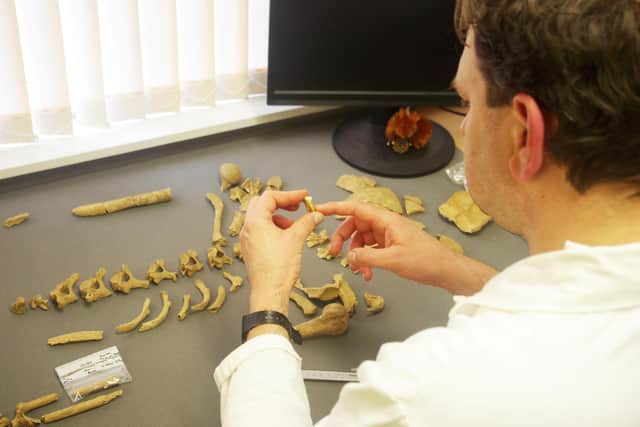Bones of 18th century shipwrecked sailor unveiled by coastal erosion
The remains of two human skeletons were discovered at Trevone and Sennen in Cornwall before they were carefully excavated. Now, the Cornwall Archaeological Unit (CAU) said the analysis of the the bones found near Trevone in 2022 suggest the body was from the 18th century.
A skull found during a beach clean at Sennen last winter was about 3,300 years old.
Advertisement
Hide AdAdvertisement
Hide AdAnn Reynolds, Senior Officer for the Rural Historic Environment at Cornwall Council said the remains at Trevone were likely to be a male between 25 and 40 years old.


She said: "The bones suggest that the individual had done a lot of very heavy manual labour like pulling and hauling, suggesting that they had very well-developed upper body muscle. These activity-related changes to the back of the head, shoulders and upper arms are consistent with an active lifestyle involving persistent use of the arms and shoulders.
"Wear to the teeth may also be consistent with a sailing lifestyle as there is a suggestion of repeated holding of cord or rope in their mouth. In all, the evidence is as good as we will ever get to suggest that this was indeed an 18th century shipwrecked sailor."
All that was left of the remains found at Sennen was the skull of the body which the CAU was able to place as having lived 3,300 years ago.
Ms Reynolds said: "Given this age, it is more likely that this was a grave site that has been washed out by successive storms, and the remains gradually washed away until only the head remained and was spotted during a beach clean. We cannot tell much more due to the limited survival of the bones, but it might be male and of around middle age. Although the cranium had noticeable thickening which is more often observed in older women."
Martyn Alvey, portfolio holder for Environment and Climate Change at Cornwall Council, added: "This is a fascinating insight into the life and times of a mariner which is so synonymous with Cornwall and our seafaring history. It will be interesting to see what else the wonders of modern science and forensics may be able to discover about this man, and the individual from Bronze Age times, before they are finally laid to rest once more."
When any human remains are discovered, they should not be touched or moved and should be reported immediately to the police.
Comments
Want to join the conversation? Please or to comment on this article.